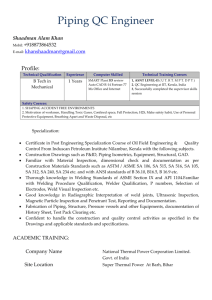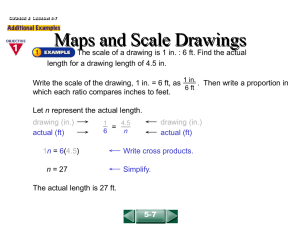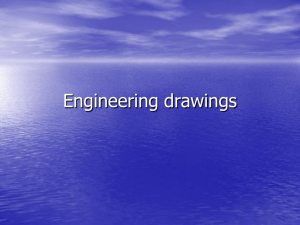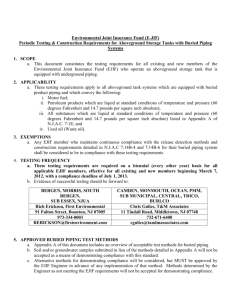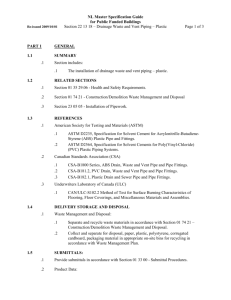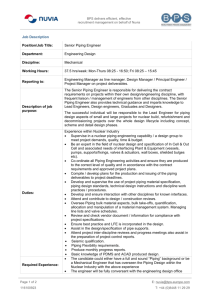Piping_systems
advertisement
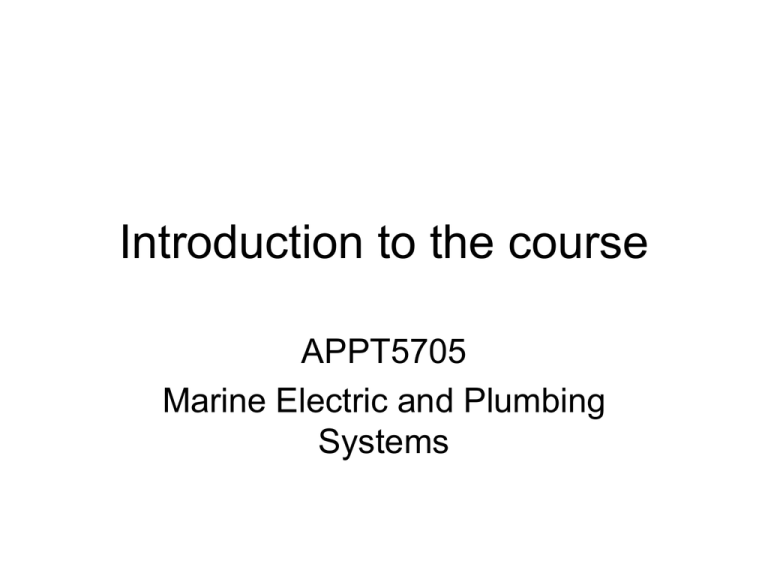
Introduction to the course APPT5705 Marine Electric and Plumbing Systems General Task • This course is a project based • Your task is to design plumbing and electrical systems for a project boat. • The chosen boat is Chris Lovegrove design where you already have done general arrangement and propulsion system. Assignments Drawings and Reports are split in two areas: • Plumbing: Drawings and a report with one due date 4 September 2014 • Electrical: Drawings and a report with one due date 30 October 2014 For details see the very assignment pack Piping systems drawings Piping systems comprise the following systems: - Domestic Hot and Cold Water System - Sewage and Sanitary System - Bilge and Deck wash System - Hydraulic System - Fuel System, Raw water, Exhaust System - Ventilation, Heating and Air Conditioning System - Compressed Air System - Refrigeration System - Fire Fighting System Piping as a part of good design • Size allocation on preliminary General Arrangement of the boat is often inappropriate to accommodate all specified equipment. If it becomes clear at 80% of building stage the headache is quite serious. • Not only the size and placement of equipment spaces are of importance but also the allocation of spaces for trunking and piping. Piping and trunking can take up a surprising amount of space. Good designer will always allocate suitable spaces and tolerances within his/her arrangement. That’s why the ability to PLAN AHEAD is what makes the designer really good. Photo gallery Let we see some photographs from installed systems: Please make a guess • What systems are shown • What is the material of the pipes and fittings Piping design – drawings • Schematic drawings It is a general requirement according to most Classification Societies Rules. For larger craft many companies adopt the method of having a separate diagram for each of the piping systems. It simplifies the work and minimizes possible mistakes. For smaller crafts some schematics of the system can be combined in one drawing. If the system is simple enough no further drawing could be required. Schematic drawings • The main purpose is to clarify what equipment is to be installed in the specific system and what is the connection between them. The size of the pipes and material should be as well given. • To give clear view what the system consist of number of symbols are used. Symbolical image of pipes is continuous lines normally vertical and horizontal. Where pipes are crossing each other but are not in any connection the lines are also crossing. Connections are represented by a filled point. Schematic drawings Valves, pumps and other components of the system can be symbolised as follows: Other symbols can be used as well Direction of the flow could be denoted by arrows. Diagrammatic Positioning drawing • On this type of drawing the size of main components of the systems is scaled to suit general boat layout. Position of the main components in the boat is clear. Piping routing is more or less generalized. The boat components (boat lines, bulkheads, engine, banks, etc.) are shown by lightweight lines only for reference. Each item of the system is denoted by a number. Drawing should contain a specification clarifying the meaning of the numbers. • This type of drawing can replace a detail drawing for smaller boats and relatively simpler systems. Detailed drawings • This type of drawings is done on base of schematics. It shows every pipe bend, flanged joint and every piece of equipment. Many small boat builders do not use detailed drawing for pipe work since their workforce can interpret correctly not to much sophisticated systems on a small craft. But some areas like engine room appear to be more and more complex lately. Positioning and identification of all pipes and equipment pieces is required. Usually this information is given in 3 dimensions. CAD programs are very useful in to prepare a 3D electronic model. Scale models • Another form of representation of piping systems is by producing a scale model of the whole vessel or just the engine room. This is an expensive process and is accepted by large companies. • The model is dismountable and it is made in precise scale usually 1:5 or 1:10. All pipes are color coded and labeled. The construction requires very skilled model makers. Each piece of the model can be used for producing a pattern for production. • Most of possible errors are avoided but the method is too labor consuming though is well repayable for line production. Since the model is permanent it can be used for further modifications. In-situ manufacture • The method is often used in small craft building production. The boat builders work from a schematic drawing and are planning the pipe and trunking runs on the vessel itself. Usually a wire frame work in built up of 5mm diameter steel rod bent and welded together. Design requirements During the design process of piping system there is a various aspects to consider. Finally the installation must be: • Logical and Practical • Safe • Efficient • Fulfils its specification • Neat • Cost Effective • Serviceable • Does not interfere with other systems • Long lasting Golden Rules See your handouts Materials for Piping Systems, Equipment and fittings Term ‘fitting’ cover: • Valves • Branch and bulkhead pieces • Reducers • Elbows • Junction pieces • Strainers • Filters • Expansion pieces In summary everything in piping system that is not pipe and specific item of equipment General requirements to the materials: 1. Sufficient strength or load carrying ability at the operating temperature and pressure 2. Retention of suitable ductility and impact properties at all operating temperatures 3. Satisfactory corrosion and erosion resistance to the liquid or gas that it carries or in contacts 4. Resistance to galling with mating materials in moving contact 5. Compatibility with other materials in the system What factors will influence our choice? a. The type of the service – specific chemical content of the liquid or gas carrying, temperature and pressure b. Availability of the material and equipment c. Cost d. Joining ability or forge ability, cast ability e. Time availability for purchase, delivery or manufacture Materials used for Piping arrangements: • • • • • • • • • Cast Iron Wrought Iron Steel Cooper Brass and bronze Stainless Steel Aluminum Alloys Rubber Plastic Plastics • Cannot be used for continuous service above 50oC and not acceptable if there is likely to be fire hazard • Have a high coefficient of expansion (8 x steel) • Have a low modulus of elasticity (about 10-2 x steel) Plastic pipes therefore requires many more supports than cooper • Although theoretically pipes can be joined with plastic cement or welding the joints are often not properly made and leak in time Corrosion • Corrosion and erosion are unremitting enemies. Often they are encountered simultaneously and the problems they pose demand consideration when deciding the choice of material




